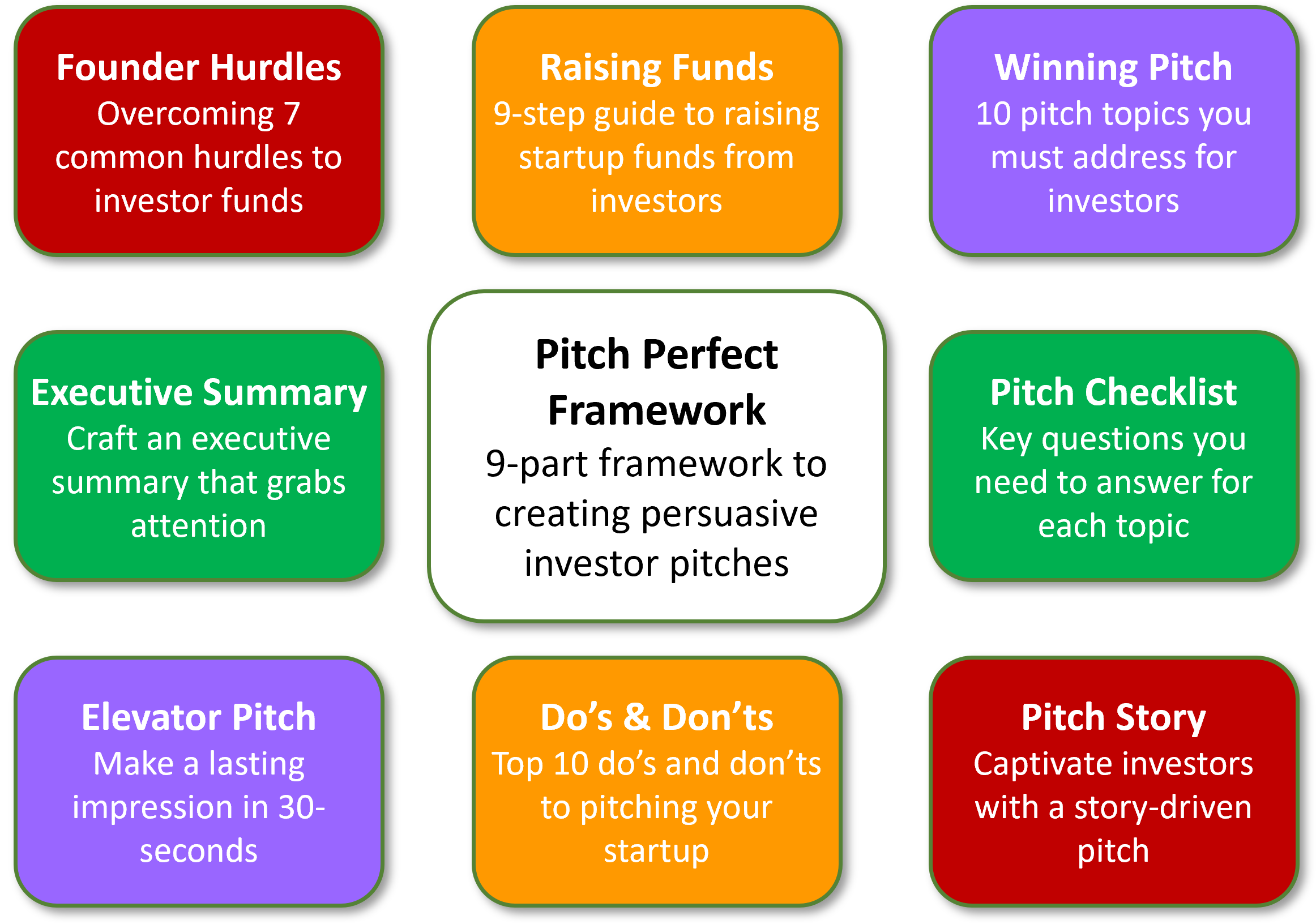Pitching investors and securing funding is a crucial step for many startups. But it can often be a challenging and time-consuming process.
As I’ve observed from reviewing hundreds of pitches, many founders struggle at different stages of the startup journey:
- Establishing the business foundation, including the problem and the market
- Identifying the right investors, with the criteria that match the business
- Preparing the pitch materials, such as the pitch deck and executive summary
- Communicating the value of the startup, based on the foundation
- Raising funds by making a case to the investors
These struggles impact the founders’ ability to keep the startups going and to get the resources needed to grow the startups.
That's why I created the Pitch Perfect Framework as a 9-part series to help founders attract investors and secure funding. The framework and the related articles provide the strategies and techniques that founders need to achieve business growth.
The goal is to ensure that founders:
- Don’t have to wade through volumes of overwhelming and often conflicting guidance
- Adopt a systematic approach to attracting, pitching and convincing investors
- Leverage startup and investment insights I wish I had years ago
In the framework, I cover the essential insights from crafting a compelling pitch to creating a winning executive summary. Each article provides actionable advice that you can apply immediately to improve business growth.
The framework will help you focus on what’s most important to your startup and to the investors. They will help you improve your pitching and fundraising, and you will be much better positioned to grow your business.

1. Pitch Perfect: A 9-Part Framework to Creating Persuasive Investor Pitches
This article introduces the Pitch Perfect Framework to help you create pitch documents that attract investors and obtain funding for your startup.
This article is the first in a 9-part series that presents the critical elements you need to learn and apply to create pitch documents that make you a more effective founder.
You can use the framework and related elements to minimize the time and effort typically required to prepare and conduct pitches.
2. Overcoming the 7 Common Hurdles to Attracting Investor Funds
Many founders struggle to raise funds because they haven’t spent the time and effort to make a compelling case for investors.
If, for example, you haven’t clarified the problem, highlighted your uniqueness or validated the market, it will be more difficult to attract investors.
Understand the most common hurdles and learn the steps to avoid them and increase your odds of getting funded.
3. 9-Step Guide to Raising Startup Funds from Investors
This is a simple 9-step approach to find and pitch investors and to raise funding.
The approach highlights how to take advantage of the startup ecosystem, including individual and institutional investors.
Tip: You can iterate these steps as many times as needed to get the desired funding result.
4. Anatomy of a Winning Pitch: 10 Topics You Must Address for Investors
There is no universally accepted pitch deck template. However, there is a core set of topics that must be included in each pitch deck.
Many participants in the startup ecosystem, such as venture capitalists and accelerators, offer their own templates. Also, there are professional services that will build pitch decks, for a fee, using custom templates.
Regardless, these 10 topics are most commonly included in pitch decks. They also represent the topics investors expect to see.
Tip: These 10 core topics can be used for any pitch document, including decks, elevator pitches and executive summaries.
5. The Essential Pitch Checklist: Key Questions You Need to Answer
The most streamlined way to address the topics in your pitch deck and associated narrative is to answer the three most important questions investors will likely ask about a given topic.
Use this checklist to help you prepare more compelling pitches and preempt many investor questions. Investors will still have questions, but you will be able to have more fruitful conversations.
6. How to Captivate Investors with a Story-Driven Pitch
Addressing the 10 core topics in your pitch documents is the best way to ensure you cover the necessary content. Answering the three questions for each topic is the simplest way to ensure you present what’s most important to investors.
Structuring the necessary and important content into a compelling story is what really gets the investors excited to learn more and to potentially invest.
7. Top 10 Do’s and Don’ts to Pitching Your Startup to Investors
While there are no absolute rules for pitch deck content and design, there are principles you should adopt to improve your pitch and your chances of attracting investors.
There are also behaviors you should avoid, which negatively impact your ability to pitch.
Apply the top 10 do’s and don’ts to dramatically improve your pitch decks and narratives.
8. Master the Elevator Pitch: Make a Lasting Impression in 30-Seconds
You should always be prepared to briefly pitch your startup. This is especially true at entrepreneurial events, where investors are actively interested in hearing from founders.
Naturally, you can’t cover everything in 30 seconds, but your goal is to generate enough interest so the investors will want to schedule follow-on meetings.
9. How to Craft an Executive Summary that Grabs Attention
An executive summary is typically a 1–3-page document that distills the most valuable information about your startup. The summary can be included near the beginning of the pitch deck or used as a separate document.
This is similar to the Bottom Line Up Front (BLUF) slide, generally used in presentations to federal government agencies. The BLUF slide is particularly important to executives who want to know the decision-oriented points at the beginning.
Including an executive summary slide in your pitch deck isn’t mandatory. But it’s very useful if you want to highlight some important facts up front.
